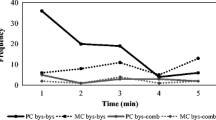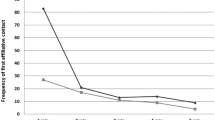Abstract
Black-and-white snub-nosed monkeys (Rhinopithecus bieti) have almost never been the subject of any behavioural observations in captivity. This study was aimed at providing preliminary information about agonistic and reconciliation behaviour in a group kept at the Kunming Institute of Zoology in China. Established procedures were used for this investigation (i.e., the postconflict/matched-control method and the time-rule method). Intra-group aggression rates were quite low. Postconflict affiliation as well as selective attraction of former opponents to each other following conflicts was demonstrated. Former opponents contacted each other earlier in postconflict periods than in matched-control periods. The average conciliatory tendency of all focal individuals combined was 54.5%. After an agonistic interaction, the first affiliative contact between former aggressors usually took place within the first minute. The behaviours most often shown as first affiliations after a conflict were body contact, mount, touch, and “hold-lumbar”, of which the latter is an explicit reconciliatory gesture. Furthermore, the adult male intervened non-aggressively in 84% of all conflicts (n=25) among the adult females. Overall, the patterns of aggression and reconciliation observed in R. bieti bear many of the traits that characterise tolerant primate species.


Similar content being viewed by others
References
Altmann J (1974) Observational study of behaviour: sampling methods. Behaviour 49:227–266
Arnold K, Barton RA (2001) Postconflict behavior of spectacled leaf monkeys (Trachypithecus obscurus) I. Reconciliation. Int J Primatol 22:243–266
Aureli F, Schaik CP van (1991) Post-conflict behavior in long-tailed macaques II. Coping with the uncertainty. Ethology 89:101–114
Aureli F, Schaik CP van, Hoof JARAM van (1989) Functional aspects of reconciliation among captive long-tailed macaques (Macaca fascicularis). Am J Primatol 19:39–51
Aureli F, Cords M, Schaik CP van (2002) Conflict resolution following aggression in gregarious animals: a predictive framework. Anim Behav 64:325–343
Björnsdotter M, Larsson L, Ljungberg T (2000) Post-conflict affiliation in two captive groups of black-and-white guereza Colobus guereza. Ethology 106:289–300
Castles DL, Aureli F, de Waal FBM (1996) Variation in conciliatory tendency and relationship quality across groups of pigtail macaques. Anim Behav 52:389–403
Colmenares F, Hofer H, East ML (2000) Greeting ceremonies in baboons and hyenas. In: Aureli F, de Waal FBM (eds) Natural conflict resolution. University of California Press, Berkeley, pp 94–96
Cords M (1992) Post-conflict reunions and reconciliation in long-tailed macaques. Anim Behav 44:57–61
de Waal FBM (1989) Dominance ‘style’ and primate social organization. In: Standen V, Foley R (eds) Comparative socioecology: the behavioural ecology of humans and other mammals. Blackwell Scientific, Oxford, pp 243–263
de Waal FBM, Ren RM (1988) Comparison of the reconciliation behavior of stumptail and rhesus macaques. Ethology 78:129–142
de Waal FBM, Roosmalen A van (1979) Reconciliation and consolation among chimpanzees. Behav Ecol Sociobiol 5:55–66
de Waal FBM, Yoshihara D (1983) Reconciliation and redirected affection in rhesus monkeys. Behaviour 85:224–241
Kappeler PM, Schaik CP van (1992) Methodological and evolutionary aspects of reconciliation among primates. Ethology 92:51–69
Kirkpatrick RC, Long YC, Zhong T, Xiao L (1998) Social organization and range use in the Yunnan snub-nosed monkey Rhinopithecus bieti. Int J Primatol 19:13–51
Long YC, Kirkpatrick RC, Zhong T, Xiao L (1994) Report on the distribution, population, and ecology of the Yunnan snub-nosed monkey (Rhinopithecus bieti). Primates 35:241–250
Ren RM, Qi H, Liang B, Bao W, de Waal FBM (1991) The reconciliation behavior of golden monkeys (Rhinopithecus roxellanae roxellanae) in small breeding groups. Primates 32:321–327
Ren RM, Yan KH, Su YJ, Zhou Y, Li JJ, Zhu ZQ, Hu ZL, Hu YF (2000) A field study of the society of Rhinopithecus roxellanae. Beijing University Press, Beijing
Sommer V, Denham A, Little K (2002) Postconflict behaviour of wild Indian langur monkeys: avoidance of opponents but rarely affinity. Anim Behav 63:637–648
Struhsacker TT, Leland (1987) Colobines: infanticide by adult males. In: Smuts BB, Cheney DL, Seyfarth RM, Wrangham RW, Struhsaker TT (eds) Primate societies. University of Chicago Press, Chicago, pp 83–97
Thierry B (2000) Covariation of conflict management patterns across macaque species. In: Aureli F, de Waal FBM (eds) Natural conflict resolution. University of California Press, Berkeley, pp 106–129
Veenema HC, Das M, Aureli F (1994) Methodological improvements for the study of reconciliation. Behav Process 31:29–38
Watts DP, Colmenares F, Arnold K (2000) Redirection, consolation and male policing: how targets of aggression interact with bystanders. In: Aureli F, de Waal FBM (eds) Natural conflict resolution. University of California Press, Berkeley, pp 281–301
Yeager CP, Kirkpatrick RC (1998) Asian colobine social structure: ecological and evolutionary constraints. Primates 39:147–155
York AD, Rowell TE (1988) Reconciliation following aggression in patas monkeys, Erythocebus patas. Anim Behav 36:502–509
Acknowledgements
I thank Dr. Gustl Anzenberger for his general support of the project and for comments on the manuscript, Prof. Ji Weizhi and Prof. Zou Rujin for permission to conduct my study at KIZ, Ding Wei for his help prior to and during my stay in Kunming, and Caroline Deak for corrections of the text. The funding came from the A.H. Schultz Foundation.
Author information
Authors and Affiliations
Corresponding author
About this article
Cite this article
Grüter, C.C. Conflict and postconflict behaviour in captive black-and-white snub-nosed monkeys (Rhinopithecus bieti). Primates 45, 197–200 (2004). https://doi.org/10.1007/s10329-004-0077-9
Received:
Accepted:
Published:
Issue Date:
DOI: https://doi.org/10.1007/s10329-004-0077-9




